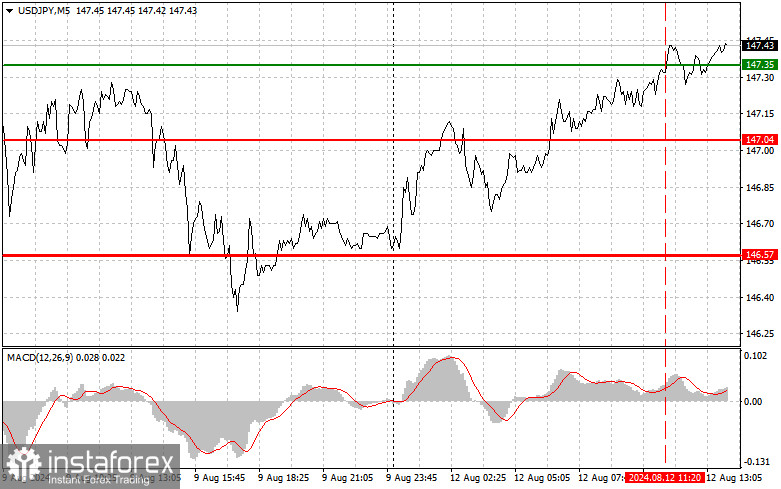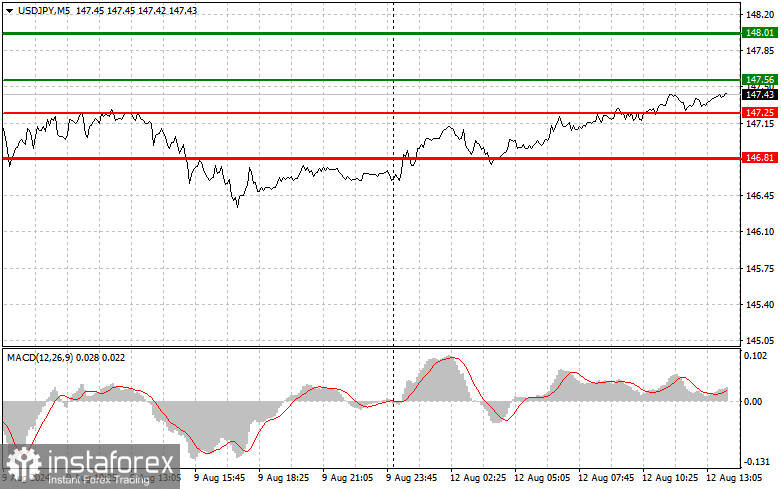Analysis of Trades and Tips for Trading the Japanese Yen
The pair continues to experience decreasing volatility. However, despite this, dollar buyers still have the advantage. The test of the 147.35 price level occurred when the MACD indicator had moved significantly upward from the zero line, which, in my view, reduced the pair's upward potential. As a result, I chose not to buy and remained out of the market. It is unlikely that we will see anything significant in the second half of the day, as there is no economic data from the US and no scheduled speeches from Federal Reserve representatives. This could increase pressure on the dollar, enabling the execution of several selling scenarios. As for the intraday strategy, I plan to act according to Scenarios No. 1 and No. 2.

Buy Signal
Scenario No. 1: Today, I plan to buy USD/JPY upon reaching the entry point around 147.56 (the green line on the chart) with the target of rising to the 148.01 level (the thicker green line on the chart). Around 148.01, I will exit the purchases and open sell positions in the opposite direction (expecting a movement of 30-35 points in the opposite direction from the level). A strong rise in the pair today is unlikely, but the upward movement may continue. Important: Before buying, ensure that the MACD indicator is above the zero line and in the early stages of rising.
Scenario No. 2: I also plan to buy USD/JPY today in the event of two consecutive tests of the 147.25 price level when the MACD indicator is in the oversold zone. This will limit the pair's downward potential and lead to an upward reversal. A rise to the opposite levels of 147.56 and 148.01 can be expected.
Sell Signal
Scenario No. 1: I plan to sell USD/JPY today after it breaks below the 147.25 level (the red line on the chart), which will lead to a quick decline in the pair. The key target for sellers will be the 146.81 level, where I will close the short positions and immediately open long positions in the opposite direction (expecting a movement of 20-25 points in the opposite direction from the level). Pressure on the pair will return if buyers do not show activity near the daily high. Important: Before selling, ensure that the MACD indicator is below the zero line and just beginning to decline.
Scenario No. 2: I also plan to sell USD/JPY today in the event of two consecutive tests of the 147.56 price level when the MACD indicator is in the overbought zone. This will limit the pair's upward potential and lead to a downward reversal. A decline to the opposite levels of 147.25 and 146.81 can be expected.

Chart Legend:
- Thin green line: The entry price where you can buy the trading instrument.
- Thick green line: The target price where you can set Take Profit or manually fix profits, as further growth above this level is unlikely.
- Thin red line: The entry price where you can sell the trading instrument.
- Thick red line: The target price where you can set Take Profit or manually fix profits, as further decline below this level is unlikely.
- MACD Indicator: When entering the market, it's important to consider the overbought and oversold zones.
Important Note:
Beginner traders on the forex market should be very cautious when making decisions about market entry. It's best to stay out of the market before the release of important fundamental reports to avoid getting caught in volatile market movements. If you choose to trade during news releases, always set stop orders to minimize losses. Without stop orders, you can quickly lose your entire deposit, especially if you do not use money management and trade large volumes.
Remember, to trade successfully, you need a clear trading plan, like the one presented above. Spontaneous trading decisions based on the current market situation are generally an unprofitable strategy for an intraday trader.
 English
English 
 Русский
Русский Bahasa Indonesia
Bahasa Indonesia Bahasa Malay
Bahasa Malay ไทย
ไทย Español
Español Deutsch
Deutsch Български
Български Français
Français Tiếng Việt
Tiếng Việt 中文
中文 বাংলা
বাংলা हिन्दी
हिन्दी Čeština
Čeština Українська
Українська Română
Română

